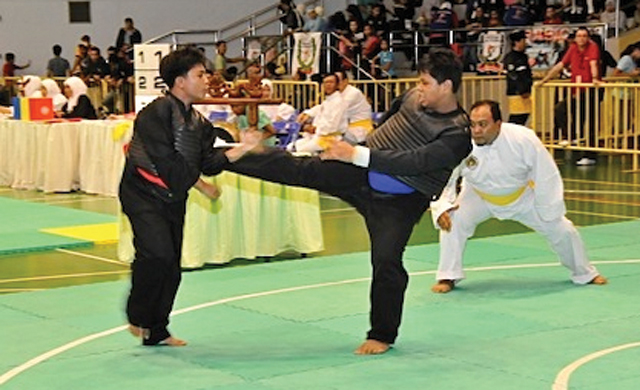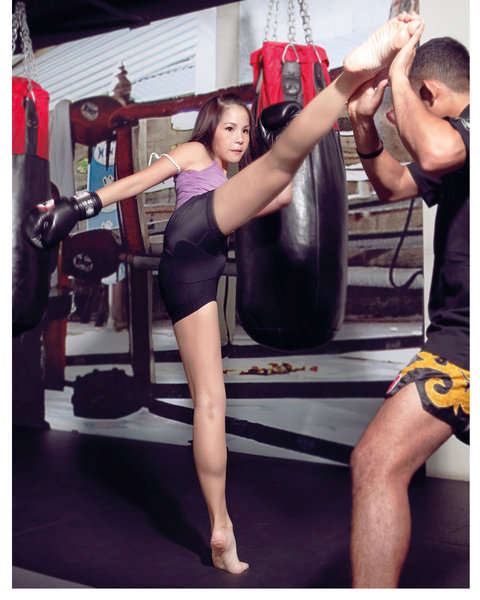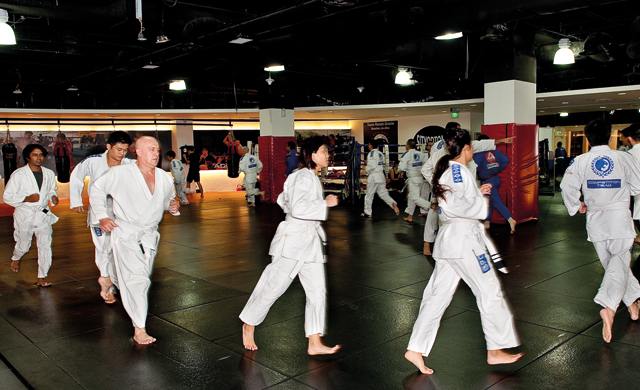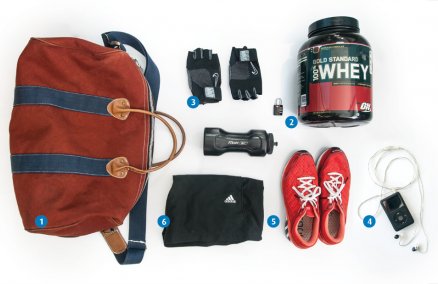Perhaps it’s just the Singaporean fondness for acronyms, but there’s no denying the astounding rise in popularity of MMA (mixed martial arts). It’s a worldwide trend, of course, but in the last 12 months, the sport (or rather, amalgam of other sports) has wrestled our city’s fitness scene to the floor and now holds it at submission point.
“MMA is the fastest growing sport in the world,” reveals Chatri Sityodtong, founder of Evolve MMA. “It has grown more than 10 times in the last eight years and Singapore is now witnessing similar numbers. We’re also going to be holding one of the world’s biggest MMA events, the ONE Fighting Championship, soon, which will be viewed across 25 countries by more than 500 million viewers. That’s major.”
MMA is not just a martial art form—it’s an integration of the best fight styles out there, including Brazilian Jiu-Jitsu, Muay Thai, wrestling and boxing, which is why it has such a lethal reputation. But we’re in Asia, a region that’s also well-versed in other forms of self-defense like silat and taekwondo. Are these more traditional fight styles suffering as a result?
“MMA is definitely growing faster than traditional martial arts. In fact, MMA is stealing market share from them. This is probably because it’s been proven recently in the UFC that 99% of the traditional martial arts do not work in real life. The ones that have risen to the top are Muay Thai, BJJ, boxing and wrestling, and these four disciplines are the foundation to MMA today,” Sityodtong explains.
But the big bosses of silat and taekwondo aren’t too worried.
“Yes, we’re definitely seeing fewer adults at our classes these days but I feel it’s only because MMA engages in much more vigorous advertising and marketing,” says Lee Pei-Fen, instructor at the Hyun Taekwondo Academy.
“MMA is a different experience altogether from silat.,” says Imran Abdul Rahman, founder of the Sports Silat Academy and SEA Games World Champion. “It began getting hyped up when people started watching UFC and movies like Pray the Devil Back to Hell—people are just attracted to the danger element. Silat however, teaches not just effective defense moves; it also teaches patience and self-control. And it’s very safe. This is why parents send their children for us to teach, which means silat will continue to enjoy a healthy share of the market.”
Whether MMA can continue to grow at the same rate remains to be seen. Right now, anyone thinking of picking up a martial art for the first time is unlikely to look anywhere else. But perhaps there really is still room for the rest. If an MMA backlash seems unlikely, it’s certainly true that these individual disciplines offer more than just ripped abs and lethal moves. Here, we take a look at five very different fight styles and where you can pick them up.
You’re the spiritual sort
 Go for: Silat. Legend has it that this Indonesian art of fighting and self-defense was developed by a female warrior who imitated the movements of a tiger and a large bird fighting with each other. Using heavily measured moves that usually involve a flick of a wrist and nimble footwork, silat can seem to the uninitiated like a slow dance of sorts, and is connected to countless Malay myths involving supernatural strength.
Go for: Silat. Legend has it that this Indonesian art of fighting and self-defense was developed by a female warrior who imitated the movements of a tiger and a large bird fighting with each other. Using heavily measured moves that usually involve a flick of a wrist and nimble footwork, silat can seem to the uninitiated like a slow dance of sorts, and is connected to countless Malay myths involving supernatural strength.
The class: Unlike other martial arts classes, silat is rarely offered on a class-by-class basis. “If you’re serious about martial arts, especially silat, you have to commit to a lifetime of learning. You don’t sign up for two weeks and stop,” says Imran, who conducts training programs alongside partner and fellow SEA Games champion Abdul Kadir. Discipline and patience are the keywords here. You won’t get much of an adrenaline rush in a beginner’s class—you’ll need to first master the basic stance, punch, kick and takedown. There are no shortcuts to this—you do it over and over until you get it right or you don’t advance to the next level. As you move forward, you’ll also learn basic artistic movements—silat’s one of the most graceful art forms in the world, and decepively lethal. As for the look? Traditional robes are provided and you’ll be practicing sans shoes.
Where to go: Sports Silat Academy, Tampines SAFRA, 1 Tampines St. 92, 6297-5659, www.silatacademy.com. Contrary to popular belief, silat training venues aren’t always dingy school halls. The Sports Silat Academy offers comprehensive venues for professional training, complete with full floor pads for safety. They’ve also opened two new outlets, one of which is at Republic Polytechnic.
How much: $42.80 per month for all programmes, with classes held once a week.
You prize grace above grappling
 Go for: Taekwondo. The Korean martial art uses a system of open-handed strikes, blocks and ubiquitous kicks and punches to maneuver takedowns, joint locks and throws. Sometimes, it also incorporates the theory of pressure points.
Go for: Taekwondo. The Korean martial art uses a system of open-handed strikes, blocks and ubiquitous kicks and punches to maneuver takedowns, joint locks and throws. Sometimes, it also incorporates the theory of pressure points.
The class: It begins with students and the instructor greeting each other with a low bow symbolizing respect, followed by a series of ankle rotations, hip-loosening exercises and basic leg stretches to warm you up. You might want to pick your partner wisely—the next bit of the class involves alternating between holding the target pad and shoving your foot in someone’s face. After what seems like an eternity of panting through front and back thrust kicks with the instructor screaming, “Kick faster!” every few seconds, you’ll be introduced to a variety of jumps and kicks. Expect the class will conclude with some core strengthening exercises and stretches to cool you down, after which even walking home will be beyond you!
Where to go: Hyun Taekwondo Academy (pictured above), #03-00, 138 Prinsep St., 6336-1455, www.hyun-tkd.com.sg. You can’t miss the place. A blown-up figure of a man in a jump-kick pose marks the building, and there are posters of the Korean flag and the Korean Taekwondo Federation crest put up in front of the training hall on the third floor to mark your destination.
How much: $150 per month, excluding $90 for registration and uniform fees.
 You think winning is everything
You think winning is everything
Go for: Muay Thai. A combat sport from Thailand, Muay Thai is sometimes known as the “Art of Eight Limbs” because of its use of everything, from the elbows to the knees, as weapons. It’s kickboxing inspired by ancient Thai folklore.
The class: Muay Thai is not for the faint-hearted. On I-S’ most recent visit, we had the privilege of watching World Champions Namsaknoi Yudthagarngamtorn and Yoddecha Sityodtong engage in a friendly striking match as a sneak preview and very nearly tried to sneak away unnoticed. When done right, a typical punch and kick routine against the target pads results in a series of whistling swishes, hair-raising smacks and low, menacing grunts—pretty intimidating stuff. After encasing your hands in huge boxing gloves, you’ll be taught the neutral stance, how to maneuver forward, side punches and how to kick properly (“Don’t kick with your toes!”). Once you’ve got those down, you’ll work your way through more challenging routines, during which everything, from the way you swing to the amount of weight you put on the balls on your feet, is scrutinized and corrected. Get everything right and you’ll soon be HUA!-ing your way to ultimate stress relief.
Where to go: Evolve MMA, #01-01 Far East Square, 26 China St., 6536-4525, www.evolve-mma.com. This academy offers a comprehensive range of classes, with most of their instructors being World Champions from established “fight clubs” all over the world, such as the legendary Sityodtong Gym in Thailand.
How much: To attend a complimentary trial class, call 6536-4525. A comprehensive membership plan will give you unlimited access to all classes including Muay Thai, in preparation for your MMA training.
You’re sick of being called “little”
 Go for: Brazilian Jiu-jitsu(BJJ). If height and speed are your main weaknesses, BJJ might just be the best combat style for you. Derived from an early 20th century Japanese martial art form, BJJ involves a lot of grappling and wrestling on the ground.
Go for: Brazilian Jiu-jitsu(BJJ). If height and speed are your main weaknesses, BJJ might just be the best combat style for you. Derived from an early 20th century Japanese martial art form, BJJ involves a lot of grappling and wrestling on the ground.
The class: The beauty of this fight style is that you don’t really need much effort—you just need to know which part of your opponent’s body to grab and twist into painful oblivion. The first thing you’ll learn is how to effortlessly drop your opponent. Once that’s settled, you’ll pick up techniques on how to block someone’s advances to your chest and limbs, and turn their position to your advantage, which when done well can result in a broken arm or neck (theirs, of course). Naturally, it doesn’t always have to be quite so violent. Even with the gloves on (so to speak), it’s a fantastic workout.
Where to go: BXG Boxing & Fitness, 324 Tanjong Katong Rd., 6348-8380, www.bxgfitness.com. Kreation Jiu-Jitsu, a grappling and MMA group based in Singapore, holds weekly classes here.
How much: $80 per month for classes once a week or $100 per month for unlimited sessions. Each class lasts an hour. There’s also a one-time $35 registration fee.
You want to do some real damage
Go for: Krav Maga. Initially created as a way to help Jewish communities defend themselves against the Nazis, Krav Maga is technically not a sport, and there are no competitions. Instead, the training is designed to get straight to the point of self defense, teaching you to utilize your own strength and surroundings to inflict maximum damage. Its growing popularity among young women is no accident—groin strikes and headbutts are integral parts of the training. Expect bruises.
The class: A typical class begins with zombie drills, where you take turns to be surrounded by “attackers.” As you attempt to block their physical contact, you’re introduced to the groundwork of the discipline as you build up situational awareness, hand-eye co-ordination and footwork, and become accustomed to the general sense of urgency. Once that gets your blood pumping, the instructor will demonstrate and explain individual techniques, breaking them down stage by stage until you’re able to copy them with “dry drilling.” Chief instructor Sascha Soliano stresses the importance of the three Rs: Rehearsal, rehearsal, rehearsal, until you build up your muscle memory. Only then can you graduate to the “aggressive attacks,” using full safety gear to practice your responses to violent confrontation. Emphasis is placed on creating realistic simulations, so that when the real thing happens you’ve built up enough mental strength to avoid panicking. Once you've reached both physical and emotional exhaustion, a cool down at the end of class involves discussing your mental state and confidence, with a debriefing and run-through of probable scenarios designed to make you feel more prepared for whatever life throws at you.
Where: Krav Maga Singapore, #03-00 Hui Seng Building, 38 Carpenter St., 9475-9012, www.kravmaga.com.sg. There aren’t many places specializing in Krav Maga but this one stands out because it is helmed by Sascha Soliano, who served in the Singaporean HQ Commando Special Operations Force (SOTF).
How much: A single hour-long trial class costs $25 while monthly rates range from $160-350.
Watch Asia's Biggest MMA Event Here In Singapore
I-S asks: "What would you fight for?"
 Evon Tan, Fashion designer, 25
Evon Tan, Fashion designer, 25
My precious clothes! Unappreciative people strut into my store and start tugging at them. They just don’t understand the importance of designer clothes! How dare they!

Gene Khor, Writer, 31
Democrahahahahaha! Sorry, couldn't say that with a straight face.

Wayne Ree, Writer, 29
My right to paaaaaarty. (Had to be said.)
 Zea, Webmaster, 28
Zea, Webmaster, 28
I once fought hard to get back the 45 cents that a vending machine swallowed, and got a nice cup of mocha instead of the tomato soup I originally wanted dispensed. I demand for what’s right and will never give in to any big corporation that tries to take my dollars and cents.
Advertisement















